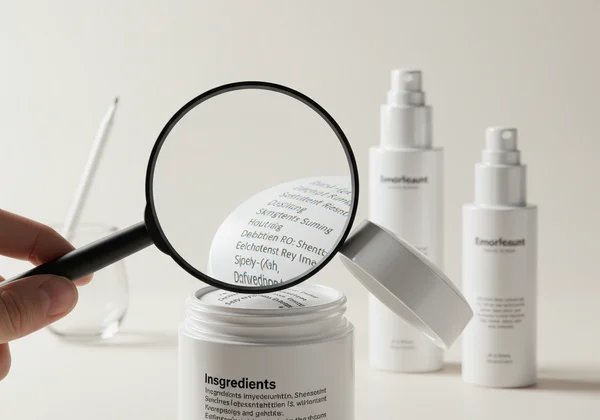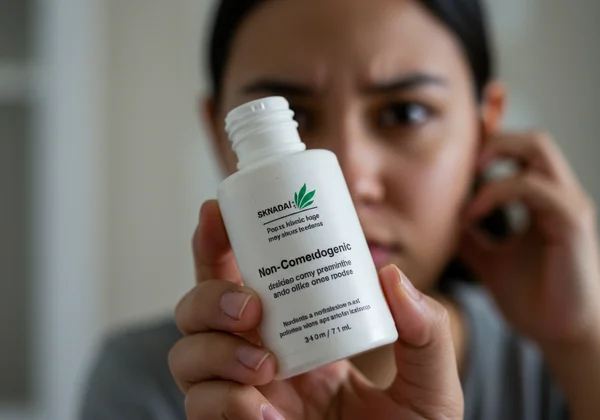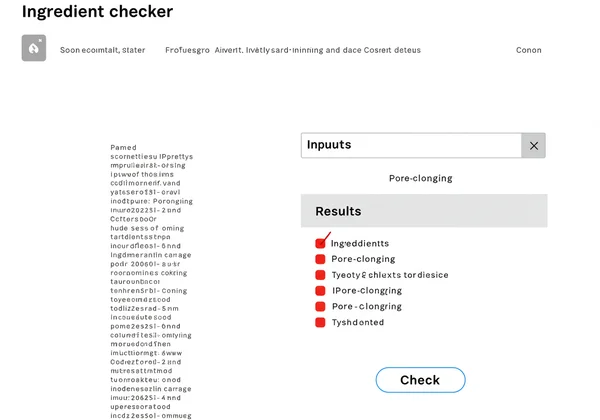ニキビに安全なスキンケア習慣を、毛穴詰まりチェッカーで始めましょう
ニキビを繰り返すことと、分かりにくい製品表示を読むことにうんざりしていませんか?私たちは理解しています。効果的なスキンケア習慣を築くことは、まるで当てずっぽうのように感じられるかもしれませんが、そうである必要はありません。真に ニキビに安全なスキンケア習慣 を作る方法を見つけることは、シンプルで強力な1つのステップから始まります。それは、製品に含まれる隠れた毛穴詰まりの原因物質を特定し、除去することです。 製品が毛穴を詰まらせるかどうかを確認する方法は? このガイドは、当社の 毛穴詰まりチェッカー ツールを活用して、よりクリアで健康的な肌のための、情報に基づいた自信のある選択をするための知識を提供します。
これは、単に1つや2つの「避けるべき」成分を避けるというだけではありません。それは、あなたのスキンケア習慣全体を理解することです。洗顔料からファンデーションまで、すべての製品が重要です。正しい知識とツールがあれば、あなたはついにニキビの悪化に反応するのをやめ、積極的に予防することができるようになります。隠された原因を 明らかにし、あなたの肌の未来をコントロールする時です。

ニキビに安全なスキンケア習慣がクリアな肌に不可欠な理由
一貫性があり効果的な ニキビに安全なスキンケア習慣 を作ることは、ニキビができやすい肌を管理するための基盤です。これは、単なるスポット治療以上のものです。それは、日々の毛穴詰まりのリスクを最小限に抑えるための包括的な戦略です。コメドジェニック(毛穴を詰まらせる)成分を含まない製品を意識的に選択することで、新しいニキビができる可能性を減らし、肌が回復してクリアな状態を保つことができます。
この積極的な戦略は、既存のニキビを治療することから、ニキビを未然に防ぐことに焦点を移します。肌に必要なものだけを提供し、既知の刺激物を避けることで、肌が健やかに育つ環境を作り出します。この戦略はあなたを武装させ、悩める消費者から、自身の肌の健康を築く知識豊富な建築家へと変貌させます。
製品が毛穴を詰まらせる仕組みの理解
毛穴が詰まる(コメド)とは、過剰な皮脂(肌本来の油分)、死んだ皮膚細胞、その他の老廃物が毛包内に閉じ込められることで起こります。「コメドジェニック」として知られる特定の化粧品成分は、このプロセスに大きく寄与したり、悪化させたりする可能性があります。これらの成分は、毛穴に栓をして、黒ニキビ、白ニキビ、または炎症性ニキビを引き起こす可能性があります。
どの成分が毛穴を詰まらせるのか という問題は、個々の肌の反応が異なるため、複雑です。しかし、科学的研究により、ココナッツオイルのような重いオイルから、ミリスチン酸イソプロピルなどの特定の化合物まで、多くの一般的な原因物質が特定されています。これらの物質は毛穴の内壁に付着し、皮脂の自由な流れを妨げ、最終的にニキビのサイクルを引き起こす可能性があります。

「ノンコメドジェニック」表示だけの限界
あなたは、数え切れないほどの製品ラベルに「ノンコメドジェニック」という言葉を目にしたことがあるでしょう。それは安全な賭けのように思えます。しかし、この用語はFDAや他の主要な規制機関によって規制されていません。これは、ブランドが独自の基準に基づいてこのラベルを使用できることを意味します。その基準は、厳格でなかったり、普遍的に適用可能でなかったりする可能性があります。「ノンコメドジェニック」と表示された製品でも、多くの個人にニキビを引き起こすことが知られている成分が含まれている場合があります。
そのため、マーケティング上の主張だけに頼るだけでは不十分なのです。真に ニキビに安全なスキンケア習慣 を築くには、客観的で偏りのない分析が必要です。製品の全成分リストを包括的な科学データベースと比較する、専用の ノンコメドジェニックチェッカー は、マーケティングの裏側を見て、実際に肌に何を塗っているのかを理解する力を与えてくれます。

ノンコメドジェニックなスキンケア習慣のためのステップバイステップガイド
あなたの完璧な ノンコメドジェニックなスキンケア習慣 を築くことは、現在の製品を監査し、今後より賢明な選択をするためのステップバイステップのプロセスです。それを、あなたの化粧台の断捨離だと考えてください。古い原因物質は捨て、クリアな肌のための救世主を迎え入れましょう。各ステップを順を追って説明し、毛穴詰まりの可能性のあるすべての製品をどのように審査するかを強調します。
洗顔料から始める:毛穴詰まりを起こす洗顔料の見分け方
洗顔料は、最初で最も基本的なステップです。良い洗顔料は、肌の自然なバリアを剥がしたり、残留物を残したりすることなく、汚れ、油分、メイクを効果的に除去する必要があります。残念ながら、多くのクリーミーまたは「保湿」洗顔料には、ラウリン酸やステアリン酸などの油分や脂肪酸が含まれており、これらは一部の人にとってコメドジェニックになる可能性があります。
お気に入りの「優しい」洗顔料が、実はニキビを悪化させていたと知ったら?私たちのチェッカーは、そのようなショックを避けるのに役立ちます。新しい洗顔料を購入する前に、その成分リストをコピーして、スキンケア成分チェッカー を使用して、赤信号がないか分析してください。あなたの目標は、徹底的に洗浄され、完全に洗い流され、毛穴詰まりにつながる残留物を残さない洗顔料を見つけることです。
ニキビに安全な成分のためのトリートメントと美容液の評価
美容液やトリートメントは、強力な有効成分を肌の奥深くまで届けるように設計されています。しかし、これらの有効成分を運ぶベースの処方が、問題の原因となることがあります。ビタミンC美容液や保湿ヒアルロン酸美容液は、毛穴詰まりを引き起こす可能性のある増粘剤やエモリエント剤で処方されている場合があります。
「ニキビができやすい肌」向けとマーケティングされている製品が、自動的に安全だと仮定しないでください。マーケティングのハイライトだけでなく、スキンケア成分 の全リストを精査してください。効果的な習慣は、有益な有効成分が、最終的にそれらの肯定的な効果を損なうベースで届けられていないことを保証します。
保湿剤と日焼け止めの賢い選択
保湿剤と日焼け止めは、毎日の必需品ですが、毛穴詰まりの最も一般的な原因の2つでもあります。多くのリッチなクリームにはシアバターのような重いバターが含まれており、一部の化学的紫外線フィルターは、敏感な個人においてニキビを引き起こすことが経験的に関連付けられています。毛穴詰まりを引き起こすことなく、適切な水分補給と保護を提供する処方を見つけることが重要です。
ここで、ニキビ成分チェッカー が非常に役立ちます。あなたは数秒で5つの異なる日焼け止めを比較し、既知のコメドジェニック成分が含まれているものを即座に特定できます。これにより、毎日恐れることなく、たっぷりと塗布できる軽量で安全な処方を見つけることができます。
お忘れなく:メイクアップやヘア製品もニキビの原因になり得ます
あなたのスキンケアは、保湿剤で終わりではありません。一日中着用するファンデーション、コンシーラー、プライマーは、直接肌に触れています。同様に、コンディショナー、美容液、ポマードなどのヘアスタイリング製品は、顔、生え際、背中に簡単に付着し、持続的なニキビを引き起こす可能性があります。これはしばしば「ポマードニキビ」と呼ばれます。
肌に触れるすべての製品に成分の調査を広げることが重要です。生え際、額、または背中にニキビがある人にとって、包括的な ヘア製品ニキビチェッカー 機能は不可欠です。製品を顔に近づける前に、製品をチェック して、クリアであることを確認してください。
すべての製品に毛穴詰まりチェッカーを活用しましょう
これで「なぜ」と「何を」は分かりましたが、「毛穴詰まりチェッカーを効果的に使用する方法」を疑問に思っているかもしれません。毛穴詰まりチェッカーツールをあなたのショッピング習慣に統合することは簡単で、クリアな肌を維持するための最も強力なツールになります。それは、圧倒された初心者から経験豊富な成分検査官まで、誰のためにでも設計されています。
私たちのツールは無料で、偏りがなく、コメドジェニック成分に関する科学的研究に基づき、定期的に更新されるデータベースによって提供されています。それは、あなたが数秒で任意のスキンケア、メイクアップ、またはヘア製品を分析する能力を与え、あなたのために本当に機能する習慣を築く自信を与えてくれます。
クイックスタート:無料成分チェッカーの使い方
始めるのは、コピー&ペーストと同じくらい簡単です。1分未満で製品を分析する方法は次のとおりです。
- 成分をコピーする: 製品の完全な、カンマ区切りの成分リストを見つけます。通常、製品の箱または公式ウェブサイトに記載されています。
- チェッカーに貼り付ける: 当社のホームページにアクセスし、成分リスト全体を入力ボックスに貼り付けます。
- 即時結果を得る: 「チェック」をクリックします。私たちのツールはリストを即座に分析し、潜在的な毛穴詰まり成分を赤でハイライト表示し、一目で明確にします。
それだけです。わずか3つの簡単なステップで、私たちの 無料成分チェッカー を使用して、棚にある、またはオンラインショッピングカートにあるすべての製品を審査できます。

スキンケア習慣の移行:製品の交換のヒント
問題のある成分を含む製品を特定したら、すべてを一度に捨てなければならないと感じる必要はありません。徐々に移行することは、あなたの肌とあなたの財布にとって最善であることがよくあります。重いナイトクリームやファンデーションなど、最も問題があると思われる製品を交換することから始めてください。
一度に1つの新しい「クリーン」な製品を導入し、肌が調整するのに数週間かかります。これにより、肌の反応を監視でき、新しいニキビが発生した場合、原因をより簡単に特定できます。このプロセスでは、忍耐と一貫性があなたの最良の味方です。
コントロールを取り戻す:ニキビに安全なスキンケア習慣で自信を築きましょう
ニキビに安全なスキンケア習慣を築くことは、あなたのスキンケアジャーニーをコントロールするための最善の方法です。マーケティング上の主張を超えて、製品の実際の成分に焦点を当てることで、推測を排除し、あなたが当然受けるべきクリアで健康的な肌を最終的に達成することができます。
反応するのをやめて、予防を始める準備はできていますか?今日、最初の一歩を踏み出しましょう。製品を集め、ホームページにアクセスし、分析を開始 してください。隠された原因を明らかにし、あなたを完全にコントロールできる習慣を築きましょう。
ニキビに安全なスキンケア習慣を築くことに関するよくある質問
現在の製品が毛穴詰まりの原因になるかどうか、素早く確認するにはどうすればいいですか?
最も速く、最も信頼できる方法は、オンラインツールを使用することです。製品の完全な成分リストをコピーして、当社のオンラインツール に貼り付けるだけです。それは、既知のコメドジェニック成分のデータベースと即座に照合し、潜在的な問題がある場合はハイライト表示します。
避けるべき最も一般的な毛穴詰まり成分は何ですか?
リストは長いですが、最も頻繁に引用される原因物質には、ココナッツオイル、ミリスチン酸イソプロピル、パルミチン酸イソプロピル、パルミチン酸エチルヘキシル、およびローレス-4などが含まれます。ただし、肌の反応は非常に個人的であるため、少数の特定の成分を避けるよりも、処方全体を包括的に分析することが常に効果的です。
パッチテストは、製品がニキビに安全かどうかを判断するのに十分ですか?
必ずしもそうではありません。パッチテストは、潜在的なアレルギー反応や即時の刺激(赤み、かゆみ)を特定するのに優れています。しかし、コメドジェニック反応(毛穴詰まり)は、ニキビとして現れるまで数週間かかることがあります。製品はパッチテストに合格しても、時間とともに毛穴を詰まらせる可能性があるため、常に成分をチェック して、コメドジェニックの可能性を確認することが重要です。
ニキビに安全なスキンケア習慣から結果が出るまでどのくらいかかりますか?
忍耐が鍵です。肌の自然なターンオーバーサイクルは約4〜6週間です。これは、完全にノンコメドジェニックなスキンケア習慣に切り替えた後、新しいニキビの顕著な減少を確認するには少なくともそれだけの時間がかかることを意味します。結果を最大限に引き出すためには、新しい安全な製品にこだわり続けることが、スピードよりも一貫性よりも重要です。
免責事項:この記事は情報提供のみを目的としており、医学的アドバイスを構成するものではありません。当社のツールによって提供される情報はガイドであり、専門の皮膚科医との相談に取って代わるものではありません。